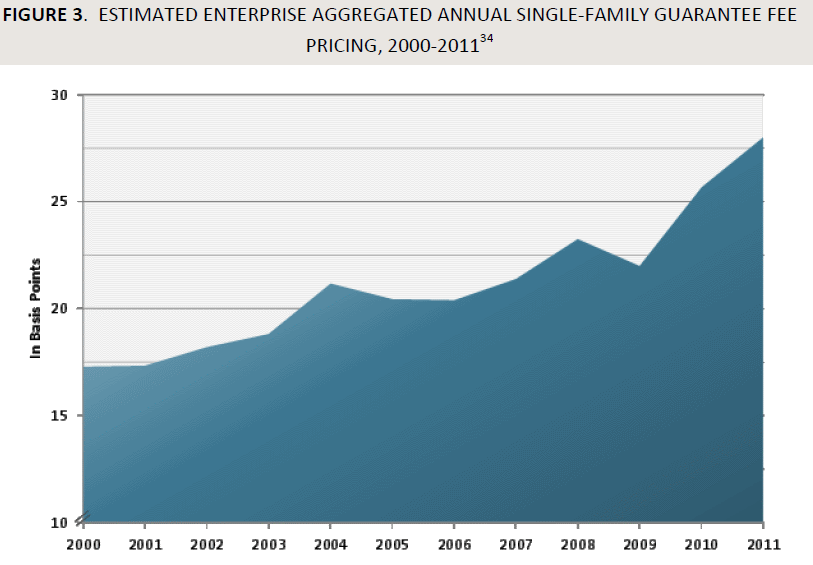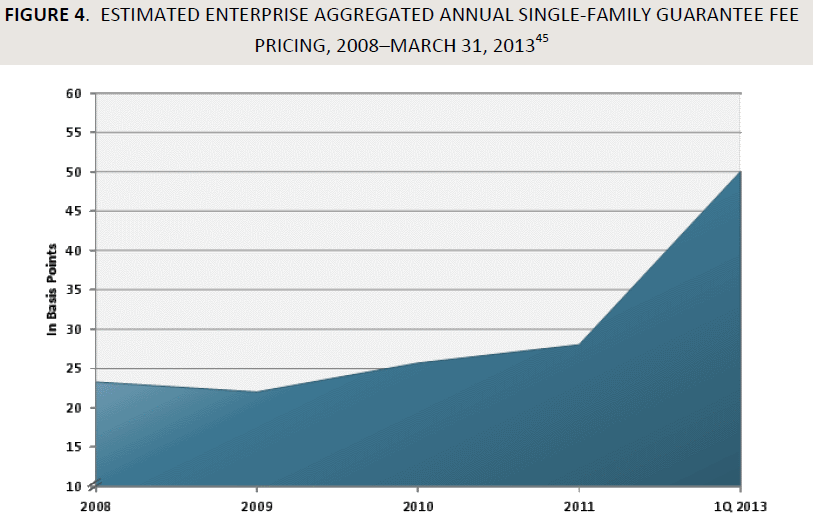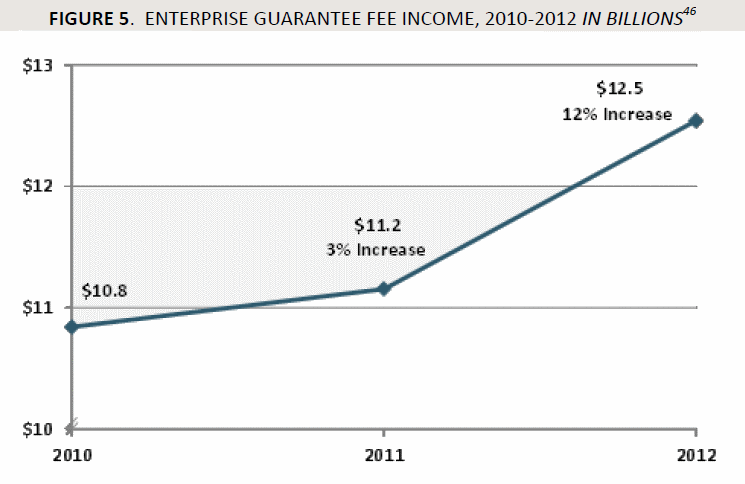Blog

Agencies Scuffle Over Best Way to Make Loans More Expensive
<pThernOffice of Inspector General (OIG) of the Federal Housing FinancernAgency (FHFA) has expressed some skepticism about FHFA’s plans torngradually raise the guarantee fees (G-fees) of Freddie Mac and FanniernMae in an attempt to lure private investors back into the housingrnfinance system. In a report issued earlier this week, the OIG looks at thernmethods the two government sponsored enterprises (GSEs) used in thernpast to determine frees, the recent history of G-fee increases, andrnhow FHFA will determine if their private sector goals are reached. </p<pInrn2012 the GSEs generated $12.5 billion in revenues from thernsingle-family G-fees they charge to protect investors in theirrnmortgage-backed securities (MBS) against potential credit losses. FHFA has argued that the federal financial support for the GSEs hasrnallowed them to set their fees artificially low, increasing theirrnrisks and pricing competitors out of the market. FHFA has directedrnthem to increase fees so as to encourage greater private sectorrninvestment in mortgage credit risk, lessen taxpayer risk, and reducernthe dominant position the GSEs hold in housing finance.</p<pAtrnthe same time the Federal Housing Administration (FHA) under thernsupervision of the Department of Housing and Urban Development (HUD)rnhas raised its insurance premiums several times in recent years alsornin part to encourage private sector investment. However FHA has nowrnannounced it is discontinuing further premium increases. OIGrnconducted its evaluation to analyze FHFA’s initiative and to assess its communications and interactions with FHA on theirrnFHA’s initiatives.</p<pThernGSEs use several methods in setting their guarantee fees. First,rneach employs a proprietary financial model to detrmine the creditrnrisk by modeling the rate at which the underlying mortgages willrndefault and the average losses on those that do (the loss severityrnrate.) If a GSE can reliably model the default and loss severityrnrates in a particular MBS set then it can estimate the credit riskrnand set an appropriate guarantee fee. The GSEs also employ theirrnfinancial models to ensure that the fees are sufficient to coverrntheir capital and administrative costs and certain other items.</p<pThernGSEs also rely upon business judgment in setting fees. They considerrnfactors such as competitive market conditions, return on capitalrntargets, and affordable housing goals. Freddie Mac told OIGrninvestigators they also have traditionally considered the financialrnmarkets’ view that Fannie Mae’s MBS offer superior liquidity to theirrnown and have attempted to provide financial incentives (i.e. lowerrnfees) to compete in the market.</p<pOIGrnsaid these methods aside, FHFA and others have argued that federalrnfinancial support for the GSEs has allowed them to set theirrnguarantee fees lower than otherwise would have been the case becauserngovernment support pre-conservatorship allowed the GSEs to issue debtrnat levels only slightly higher than those charged by the U.S.rnTreasury on securities with similar maturities. This ability tornissue debt at favorable rates has continued under thernconservatorships.</p<pFHFArntold OIG that this preferential support allows the GSEs to pricerntheir products and services, including MBS guarantee fees, at ratesrnlower than would otherwise be feasible for a profit-motivated entity,rnprovided them with an advantage over competitors that has allowedrnthem to dominate the housing finance system and amplified their risksrnbecause the fees did not fully reflect the potential credit losesrnthey would ultimately incur in fulfilling their commitments to MBSrninvestors.</p<pOIGrnfound that during the housing boom of 2004-2007 the GSEs' guaranteernfee rates were too low to mitigate the risks associated with theirrnmortgage purchase and securitization practices and ultimately thernlosses on the GSEs’ combined single family MBS guarantee businessrnreached $218 billion. These losses exceeded their available capitalrnof about $78 billion at the beginning of the conservatorship by arnfactor of about three to one. Starting in late 2007 the GSEs startedrnto increase the fees to better protect themselves against creditrnlosses and this trend has continued under the FHFA conservatorship.</p
 </p
</p
FHFArnandrnEnterprisernofficialsrnhavernprovidedrnseveralrnreasonsrnforrnthernlowrnguaranteernfees</bsetrnduringrnthernhousingrnboomrnyears.rnThey have said that the financial models severely underestimated thernrisk from Alt-A and other mortgages and failed to predict the drasticrndecline in house prices when the housing bubble collapsed. They alsornconcede that the guarantee fees were sometimes lower than called forrnby the financial models and were sometimes based in part uponrnbusiness decisions to make the GSEs competitive with private lablernmortgage-backed securities (PLMBS) issuers.</p<pThernGSEs nearly doubled their combined average G-fees to 50 basis pointsrnin 2012 due to a legislative mandate and a directive from FHFA. Inrnan attempt to raise federal revenue, the TemporaryrnPayroll Tax Cut Continuation Act of 2011 requiredrnFHFA to increase the gees by not less than 10 points, then FHFArnrequired the GSEs to increase fees by 10 basis points as part of anrnoverall plan to increase private sector investment and gradually endrnthe GSEs’ dominance in the housing finance system. </p<pFHFArnhasrnstatedrnthatrnraising fees is consistentrnwithrneffortsrnbyrnCongressrnandrnthernAdministrationrntornreformrnthernhousingrnfinancernsystemrnand many such proposals callrnforrntherneliminationrnofrnthernGSEs inrntheirrncurrentrnformrnandrntheirrnreplacementrnwithrnarnnewrnstructure.rn FHFA'srnproposalrntorngradually downsizerntheirrnmarketrnpresencernappearsrntornbernanrnattemptrntornprovidernarnfoundationrnforrnwhateverrnstrategyrnisrnultimatelyrn adopted.</p<pTornthis end the agency says it will continue to direct the GSEs torngradually increase the fees. However,rnOIG says,rnitrnisrnnotrnclearrnhowrnmuchrnhigher</bfeesrnwillrnhaverntorngorninrnorderrntornincreasernprivaternsectorrninvestmentrnnor has FHFArndefinedrnhowrnitrnwillrnmeasurernit. ThisrnraisesrnthernlevelrnofrnuncertaintyrnassociatedrnwithrnthernAgency'srninitiative.</p
AsrnshownrninrnFigurern4,rntherntwornmandatedrnguaranteernfeernincreasesrninrn2012rncausedrnthernGSEs’ combined guaranteernfeerntornnearlyrndoublernfromrn28rnbasisrnpoints inrn2011rntorn50rnbasisrnpointsrnbyrnthernfirstrnquarterrnofrn2013.</p
 </p
</p
Moreover,rnthernEnterprises’rnguaranteernfeernincome grewrn12%rninrn2012 torn$12.5rnbillion (seernFigurern5).</p
 </p
</p
Althoughrnrecentrnguaranteernfeernincreasesrnhavernbeenrnsubstantial,rnavailablernevidencernsuggestsrnthatrntheyrnmayrnnotrnbernsufficientrntorncausernarnmaterialrnincreaserninrnprivaternsectorrninvestmentrninrnmortgagerncreditrnrisk.rn One GSE officials said the fees would, in general, need to risernconsiderably to affect such investment because they are not yet highrnenough to offset the GSEs’ traditional cost advantages derived fromrnfederal support. A private company representative said the feesrnwould need to increase by about one-third, 15 to 20 basis points,rnbefore there would be sufficient financial incentives for privaterninvestors.rn</p<pFHFArnofficials recognize the fee increases must be gradual to avoidrndisruption to the markets and have said that future increases wouldrnlikely be modest with considerable intervals between each to permitrnFHFA to assess market reaction and make adjustments as necessary.</p<pOIGrnsays FHFA has not developed any fixed definitions or methods tornmeasure private sector investment. Such evidence might include arngradual return of a revamped Private Label MBS market, perhaps to historic levelsrn(on average about 20 percent of all MBS issues in the 1990s). Or, anrnFHFA official said, financial institutions might be more willing tornhold loans in their portfolios rather than sell them to the GSEs,rnthus retaining some credit risk. Alternatively, the fees mightrnincrease private sector participation "on the margin"; thatrnis private institutions might be more willing to compete for thernpurchase of particular pools of mortgages but not conformingrnmortgages in general.</p<pOfficialsrnfrom one GSE agreed with FHFA that private investment could vary andrnbe difficult to measure. One reason is the private sector generallyrndid not securitize the types of conforming mortgages that are thernstaple of the GSEs MBS guarantee business but rather those mortgagesrnthat did not meet GSE standards . This officials also said thernincreasing lender retention of mortgages would not necessarilyrnindicate that rising G-fees were working. GSE-related credit costsrnsuch as guarantee fees are a relatively small factor in a lender’srndecision to sell a mortgage to a GSE or retain it on its own books.</p<pWhilernFHFA'srncould potentially transfer some of the creditrnriskrntornprivaternsectorrninvestors,rnitrnalsornfacesrnsomerntrade-offsrnandrnchallengesrnincludingrnreducedrndemand for mortgage credit and volume. </p<pTornsome degree guarantee fees have always been built into the cost ofrnconforming mortgages and it is likely that their inclusion in thernoverall price of mortgages has had only a minimal effect on therndemand for housing finance. However as fees continue to rise theyrncould become an important cost factor and any business must make arndecision about which increased operating costs they pass on tornconsumers. "If guarantee fee increases are limited and housing andrneconomic markets are strong, the the impact of guarantee feernincreases upon borrowers will likely be mitigated."</p
Recentrnfederal regulator initiatives designed to correct abusive and unsafernlending practices such at the qualified mortgage, retained risk, andrnability-to-repay rules could involve trade-offs that presentrnchallenges to the FHFA initiative. </p<pChangesrncould result in potential shifts in mortgage credit and risks betweenrnthe conforming and government insured markets. FHA has raised itsrninsurance premiums and tightened underwriting standards in order tornstrengthen its finances and encourage greater private sectorrninvestment in credit risk however, there is some potential that thernFHFA and FHA initiatives could result in one of their marketsrnbecoming relatively more expensive or otherwise less attractive thanrnthe other. FHFA maintains that there is not much overlap between itsrnmarket and that of FHA and both agencies have recently raised pricesrnwithout significant shifts. </p
OIGrnrecognizes the distinctions between the two but also notes that therncurrent loan limits on FHA-insured mortgages is significantly higherrnin high cost areas than the conforming loan limit which couldrnincrease the relative attractiveness of FHA-backed mortgages and,rnalthough FHFA has directed the GSEs to raise its guarantee feesrnGinnie Mae has not raised its MBS guarantee fee since 1972. Consequently there could be a growing cost disadvantage betweenrnGinnie Mae and GSE guaranteed MBS. Further, HUD announced in Aprilrn2013 that FHA would no longer increase its mortgage insurancernpremiums so the potential exists for conforming mortgages and thernGSEs’ MBS to become relatively more expensive than FHA-backedrnmortgags and Ginnie Mae issued MBS.</p
Basedrnon the above, OIG made the following findings and recommendations:</p<ul<li<pFHFArnhas yet to establish definitions or performance measurements for itsrninitiative.</p</li<li<pFHFArnshould seek to establish a more formalized arrangement with FHA tornassess key issues involving their pricing initiatives. This wouldrnaddress critical issues such as the implementatioin of their pricingrninitiatives and the potential for shifts of mortgage business andrnrisks between the two markets.</p</li</ul<pFHFArndisagreed with the findings and recommendations of the report. Inrnthe first case the agency said it had earlier addressed thosernconcerns and that, in lieu of a fixed quantitative target it intendedrnto monitor the market closely. As regards its interactions with FHA,rnFHFA said the two were established as separate and independentrnentitites and that FHFA had always found that interactions betweenrnsuch organizations are better handled informally.
All Content Copyright © 2003 – 2009 Brown House Media, Inc. All Rights Reserved.nReproduction in any form without permission of MortgageNewsDaily.com is prohibited.
Latest Articles
By John Gittelsohn August 24, 2020, 4:00 AM PDT Some of the largest real estate investors are walking away from Read More...
Late-Stage Delinquencies are SurgingAug 21 2020, 11:59AM Like the report from Black Knight earlier today, the second quarter National Delinquency Survey from the Read More...
Published by the Federal Reserve Bank of San FranciscoIt was recently published by the Federal Reserve Bank of San Francisco, which is about as official as you can Read More...

Comments
Leave a Comment